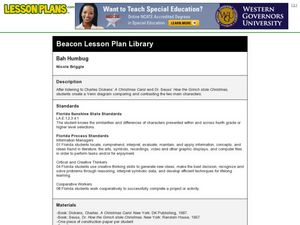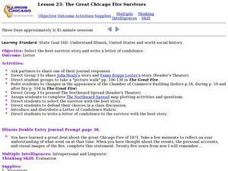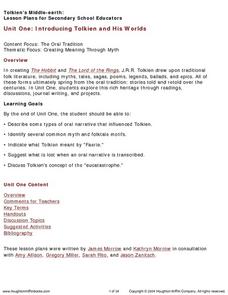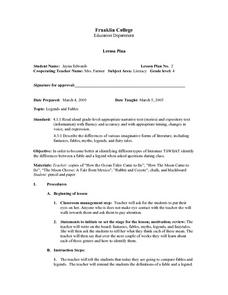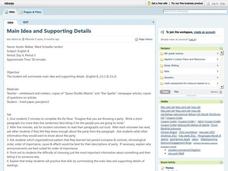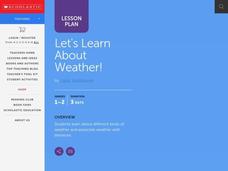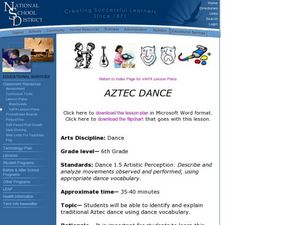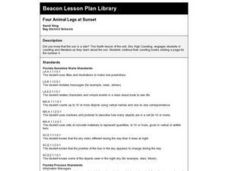Curated OER
Family Stories and Personal Narratives
Fourth graders read various stories in their literature books about families. Individually, they make a timeline showing the most important events in their lives. They bring in one artifact from their lives and write a paper about it...
Curated OER
Poseidon's Protectors to the Rescue
Students explore the concept of philanthropy. In this environmental stewardship lesson, students explore the Greek mythology story of Poseidon. Students write letters to Poseidon that address water pollution today and express how they...
Curated OER
Solar System: Let's Take a Trip
Third graders consider outer space. In this introductory solar system lesson, 3rd graders complete a KWL chart and listen to the story The Magic School Bus: Lost in the Solar System, by Joanna Cole & Bruce Degen. They will contribute...
Curated OER
Healthy Eating, Healthy Living
Students describe some ways to lead a healthy life. They watch short video clips about eating healthy, ways to create healthy meals, and the benefits of exercise. They study the food groups and play indoor exercise games.
Curated OER
Let's Get Cooking
First graders create food from their cultures and present food and its history with the rest of class. They read "Everybody Cooks Rice" and everyone tastes the meals brought into class. They write a paragraph describing the reason for...
Curated OER
Bah Humbug
Young scholars listen to two famous stories about people who do not like Christmas, and then create a Venn diagram to compare and contrast the main characters.
Curated OER
The Great Chicago Fire Survivors
Students examine documents describing the experiences of survivors of the Great Chicago Fire, and write condolence letters.
Curated OER
Ballad Blast
Students write epic poems, songs, or ballads to describe adventures of their own. They discover that storytellers often told stories as epic poems, songs, or ballads. They share and discuss some of Homer's Odyssey and Iliad.
Curated OER
Pioneers On and Off the Prairie- Willa Cather and Mary Cassatt
Students examine the written work of Willa Cather and the impressionist art of Mary Cassatt. They describe parallels in the lives and work of both women and creat a Powerpoint presentation.
Curated OER
Map Readng And Giving Directions
Learners read a story to create the context for the lesson. Then they are given or create a community map. Then students use the scenario of being lost in order to role play giving directions to a partner to find a destination. The...
Curated OER
Introducing Tolkien and His Words
Students identify and describe the types of narratives that made Tolkien the writer he was. In groups, they examine different myths and folktale motifs. They discuss what Tolkien meant by "faerie" and "eucatastrophe." As a class, they...
Curated OER
Pigs: A Visual Splendor
Third graders practice using visualization to aid in their reading comprehension. After a reading a chapter from the book "Charlotte's Web," students write a brief summary of the plot using their visualizations, aided by reading...
Curated OER
Balancing the Scales: Understanding Ratios
Students are introduced to the concept of ratios. In groups, they convert sets of numbers into a ratio. After practicing, they use the ratios and proportions to solve story problems. They also calculate map distances and discover map...
Curated OER
Legends and Fables
Fourth graders identify and discuss the differences between legends and fables. They define fable and legend, then as a class take turns reading our books. Students select two of the stories, and complete a Venn diagram, comparing one...
Curated OER
Main Idea and Supporting Details
Eighth graders identify the main idea and supporting details in paragraphs. In this language arts lesson, 8th graders review organizational patterns in paragraphs and determine which pattern is best for a given situation. Individually,...
Curated OER
Let's Learn About Weather!
Students read several weather-related stories. They brainstorm weather words and use them as they make a weather booklet that includes pictures, a story of their own, and observations they make about the weather outside on that day.
Curated OER
Quality of Information: Point of View and Bias
Fifth graders identify stereotypes of Indian people based on perceived characteristics. They discuss the misconceptions. Students define quality of information and give an example from the story "Seaman's Journal: On The Trail With Lewis...
Curated OER
Room 13
In this Room 13 worksheet, students complete nine activities related to each chapter in the book. Students do an activity to practice using the vocabulary in the book and practice letter writing with writing to a character in the story....
Curated OER
The Screwtape Letters by C. S. Lewis (Letter 20)
In this The Screwtape Letters by C. S. Lewis worksheet, learners, after reading the story, define six key vocabulary words and answer nine comprehension questions.
Curated OER
Aztec Dance
Seventh graders study Aztec dance to learn about their culture and civilization. In this Aztec study lesson, 7th graders watch a video of Aztec dancers and describe the dance on an index card. Students visit a website to learn the...
Curated OER
The Way You Dream: Gandhi and King's Visions of Nonviolence
Students read Gandhi and Dr. King's messages about nonviolence and discuss their visions about loving one's enemies. In this nonviolence lesson, students read Gandhi's "Ahimsa, or the Way of Nonviolence" and Dr. Martin Luther King's...
Curated OER
How Should You Treat Younger Children
Students recognize how younger children should be treated. In this empathy lesson plan, students listen to the story Julius, Baby of the World and then students will work on art projects with students from a younger grade level.
Curated OER
Math is Everywhere: Part 2
Second graders identify shapes and measurements in everyday life. In this measurement lesson, 2nd graders locate rectangles in their classroom and use standard and nonstandard forms to measure them. Students view a video clip...
Curated OER
Four Animal Legs at Sunset
First graders listen to the book, 1, 2, 3, To The Zoo, and focus on the one-to-one correspondence while counting the animals and other objects in the story. They create page number four in their number books.





